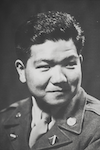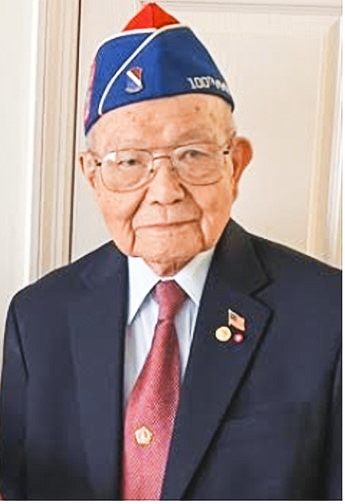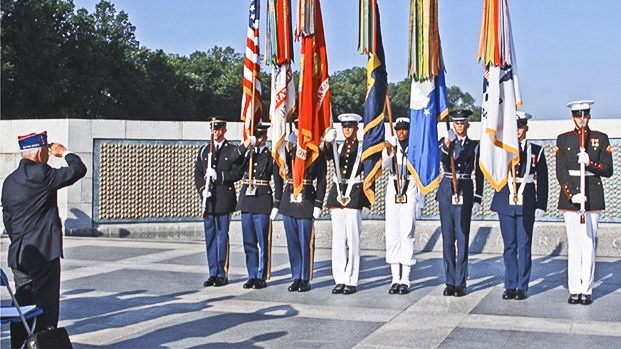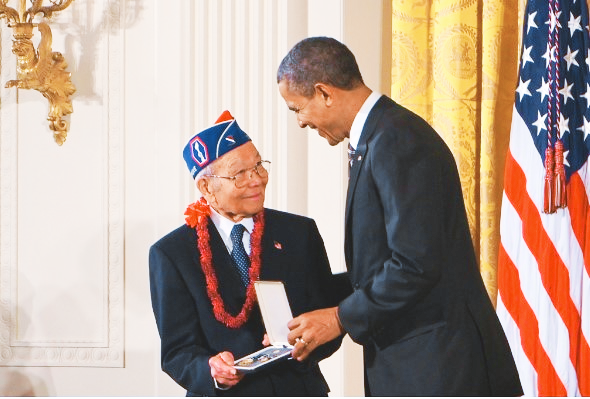By Terry Shima, 442nd RCT, WWII

Terry Shima during WWII
When Japan attacked Hawaii on Dec. 7, 1941, the White House, War Department, U.S. Congress and the American public branded ethnic Japanese in the United States as spies and collaborators for Imperial Japan.

Terry Shima in 2022
Draft classification for Japanese Americans was changed to 4-C, alien, which banned them from enlisting in the U.S. Armed Forces. Nisei drafted before World War II and residing along the Pacific Coast states were discharged; those in the interior U.S. were given menial assignments such as cleaning latrines.
Nisei draftees (1,432) in the Hawaii Territorial Guard, later designated the 100th Infantry Battalion, were shipped to the mainland for training and deployment to Italy for combat. And 120,000 ethnic Japanese, two-thirds of whom were U.S. citizens, were rounded up from the Pacific Coast states on short notice and placed in internment camps guarded by sentries on the ground and in guard towers with machine guns. Separately, over 5,500 Japanese nationals on the FBI suspect list were arrested and detained in camps run by the Department of Justice.
Japanese Americans, individually and in groups, petitioned the government to allow them to serve in combat to prove their loyalty. For this and other reasons, the superior combat training record of the 100th Battalion and the strong performance of Nisei linguists who volunteered for secret intelligence duty in the Asia Pacific Theater convinced Washington to form the 442nd Regimental Combat Team, consisting of 4,000 Nisei volunteers from Hawaii and the mainland, many from internment camps.
Many Nisei with college degrees volunteered because of the Japanese American Citizens League’s promise to help open the executive-level job market then closed to Nisei. Finding jobs for Nisei graduates, many with advanced degrees, was a pressing concern for JACL Executive Secretary Mike Masaoka during his final days in Italy prior to his discharge from the 442nd RCT.
Three thousand Nisei volunteers from Hawaii and the mainland, including many who studied in Japan, served in the Asia Pacific Theater, many in the combat zones, fighting soldiers of their parents’ homeland.
They translated captured documents, interrogated prisoners of war, intercepted enemy communications, prepared propaganda and entered caves to persuade soldiers to surrender.
Nisei served in the second or third wave of nearly every Marine and infantry invasion to provide commanders tactical intelligence information in real time for counteraction, as well as served in every unit that needed language support, in the special forces in Burma, in the caves of Yan’an, China, interrogating Japanese captured by Chinese Communists.

Terry Shima salutes at the National World War II Memorial in Washington, D.C. In the background is the Wall of Heroes. (Photos: Courtesy of Terry Shima
Each Nisei linguist in the Pacific combat zone was protected by a white bodyguard; each of them and the white officers of the 100th Battalion and the 442nd RCT were instructed to report any evidence of Nisei disloyal acts.
Another 3,000 Nisei linguists served in stateside assignments, including the Pentagon.
Following training at Camp Shelby, Miss., the 442nd, minus the First Battalion, was shipped to Italy, where it merged with the 100th BN. While the 100th retained its unit designation, it served as the First Battalion of the 442nd RCT.
After one campaign in Italy, the 442nd RCT was shipped to the Vosges Forests section of France to engage the Germans in the southern front of a two-front war. Displaying combat smarts, winning difficult battles assigned to them and accepting assignments other units declined to handle, the 442nd RCT won the respect of their fellow White infantrymen and officers from other units.
When so many combat commanders requested the assignment of the 442nd RCT to serve in their commands, the question of Nisei loyalty became a moot point.
In addition to serving as riflemen and military intelligence, Nisei were sprinkled in small numbers in the U.S. Navy, Marines, Merchant Marines, WAC, Nurses Corps and five who served as gunners in U.S. bombers flying into heavily armed German strongholds.
The War Relocation Authority said 31,000 Japanese Americans served in uniform during WWII. Japanese Americans were the only ethnic group that went into combat during WWII to prove their loyalty. When the war ended, no ethnic Japanese was convicted for collaborating with the enemy. No Nisei was court martialed for desertion.
Shortly after Germany surrendered, the War Department reportedly made two major widely publicized announcements, press releases of which are being sought:
1) The 442nd Regimental Combat Team, including the 100th Battalion, were the best combat soldiers in the history of the U.S. Army.
2) The 442nd Regimental Combat Team, including the 100th, was the most-highly decorated U.S. Army unit for its size and period of combat during WWII.
It is my view that these two U.S. Army announcements validated Nisei loyalty.
President Harry Truman reviewed the 442nd RCT on July 15, 1946, at the Ellipse, the outer south lawn of the White House. He told the Nisei, “You fought not only the enemy abroad, but you fought prejudice at home – and you have won. Keep up that fight, and we will continue to win.”
Through his remarks and personal review, Truman confirmed the Army’s validation of Nisei loyalty and removed from the table the stigma of ethnic Japanese disloyalty placed there when the war began. The first person known to the writer to make this observation was JAVA VP Col. Vic Mukai, USA (Ret), around 2004.
When WWII ended, President Truman decided to reorganize the federal government “to equalize treatment and opportunities especially for African Americans” while also recognizing the special wartime contributions of other minorities, such as the Nisei, the Navajo Code Talkers, the Chinese American pilots who flew the Hump to deliver war material to China and Filipino soldiers who served under Gen. MacArthur’s command during WWII.
These combined achievements served as the backdrop to Truman issuing Executive Order 9981 on July 26, 1948, two years after he reviewed the 442nd RCT. This landmark Executive Order, which desegregated the Armed Forces, said: “There shall be equality of treatment and opportunity for all persons in the Armed Forces without regard to race, color, religion or national origin.”
This order leveled the playing field equally for all. Randy Sowell, an archivist at the Truman Library, observed that “the contributions of U.S. minority groups to the military effort in World War II contributed to the postwar movement to end discrimination against those groups in the Armed Forces and in U.S. society at large. President Truman was disturbed by reports of mistreatment of Black and Nisei veterans by civilians after the war.”
JACL Executive Secretary Masaoka must have been pleased that his prayers were answered inEO 9981. Because of EO 9981, a few Nisei, but predominantly Sansei and Yonsei, third- and fourth-generation Japanese Americans, now would be found in all branches of service, in the cockpits of fighters and bombers as pilots, in the bridges of naval vessels and in sensitive war-planning staff positions.

Terry Shima is presented with the Presidential Citizens Medal, the second-highest civilian award in the U.S., by President Barack Obama in 2012.
During WWII, their assignments were limited to the U.S. Army, and the highest Nisei rank was major. Following the Vietnam War, over 40 predominantly Sansei and Yonsei were promoted to generals and admirals, with one, a Sansei, serving as chief of staff of the U.S. Army, a four-star position once held by Gen. George C. Marshall. Over 80 other Asian Pacific Islanders, whose WWII performance also helped make EO 9981 happen, would also achieve flag rank.
The civilian side, led by a few Nisei but predominantly Sansei and Yonsei, would witness similar breakthroughs. Thanks to the Nisei WWII endeavor, discriminatory laws were repealed, our alien parents were now permitted to become U.S. citizens; members of the U.S. Congress, now confident of Nisei loyalty, passed the Hawaii statehood bill.
The Commission of Wartime Relocation and Internment of Civilians, mandated by the U.S. Congress, concluded that internment was not necessary, that it was caused by war hysteria, racial prejudice and the failure of political leadership.
President Ronald Reagan offered a formal apology for the internment. Nisei WWII soldiers received the Congressional Gold Medal, the highest honor the U.S. Congress can bestow. Additionally, U.S. Senators selected a Japanese American to serve as president pro tempore of the U.S. Senate, a position that constitutionally put Sen. Daniel Inouye third in line for the presidency. Eighty years ago, he was banned from military service.
Sansei and Yonsei remain vigilant to defeat racism executed against Asian and non-Asian minority groups. The Nisei, Sansei and Yonsei story speaks to the Greatness of America. God Bless the USA.
Terry Shima, 442nd Public Relations, 1945-46, joined JAVA around 2000, served as executive director from 2004-12 and has since served on the board of directors and in committees. Mike Masaoka selected Terry to serve in the 442nd Public Relations Office. When Mike departed Italy to be discharged, Terry succeeded him as head of the 442nd PRO. Terry returned with the 442nd to handle public relations in New York City for the return festivities, the presidential review in Washington, D.C., and the retirement of colors in Honolulu.



